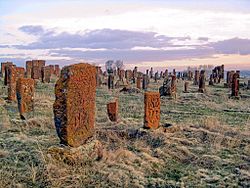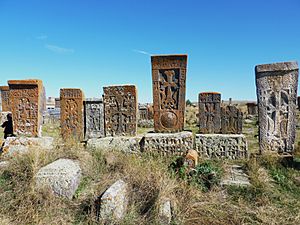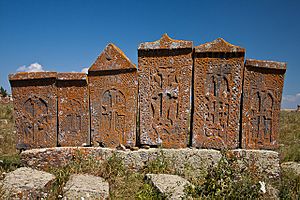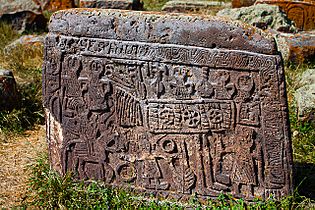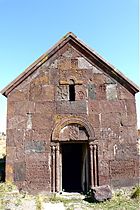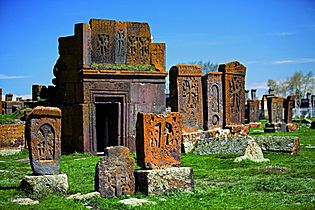Noratus cemetery facts for kids
The Noratus cemetery, also known as Noraduz, is a very old cemetery in Armenia. It's located in the village of Noratus, in the Gegharkunik Province, close to Gavar and Lake Sevan. This special place is about 90 kilometers (around 56 miles) north of Yerevan, the capital city.
What makes Noratus cemetery famous are its many ancient khachkars. A khachkar (pronounced "hahch-kar") is a unique Armenian carved stone cross. This cemetery has the biggest collection of khachkars in Armenia. It's now the largest surviving cemetery with these stone crosses, especially after many others were sadly destroyed in a place called Old Julfa.
Amazing Stone Crosses: Khachkars
The oldest khachkars you can see at Noratus cemetery were made way back in the late 900s. The art of making khachkars became popular again in the 1500s and 1600s. During this time, Armenia was under the rule of the Safavid Empire, and you can see some Eastern art styles in the khachkars from this period.
Three skilled artists carved khachkars here during that time. The most well-known was Kiram Kazmogh, who worked from 1551 to 1610. Other carvers included Arakel and Meliset.
The cemetery is huge, covering an area of about seven hectares (that's like 17 acres!). It holds almost a thousand khachkars, and each one has its own special and different designs. Many of these old stone crosses are covered in moss and lichen, which makes them look even more ancient. Some of the tombstones even show carved pictures of weddings and daily farm life.
Next to this old cemetery, there's a newer, modern cemetery, separated by a fence. Also, nearby in the village, you can find the Holy Virgin church, which was built in the 800s. One of the khachkars from Noratus cemetery was given to the British Museum in London in 1977. This particular khachkar has a cross with leaves and smaller crosses, all surrounded by pretty designs like trefoil and grapes. There's also an old message carved on it, asking for God's kindness for someone named Aputayli.
Interesting Stories and Legends
There are some cool old stories connected to Noratus cemetery. One popular tale is about the army of Tamerlane, a famous conqueror. The story says that when Tamerlane's army was coming, the villagers put helmets on top of the khachkars and leaned swords against them. From far away, the khachkars looked like armed soldiers ready to fight. Because of this clever trick, Tamerlane's army got scared and turned back!
Another interesting story is about a monk named Ter Karapet Hovhanesi-Hovakimyan, who lived in the 1800s. He was from a monastery near the village and often performed burial services at Noratus. To save himself the long, two-hour walk back and forth, he built a small room for himself right in the cemetery.
When he was 90 years old, he asked his fellow monks to bury him alive. His last words were: "I am not afraid of death. I want you to not be afraid either. Never fear anything, except God alone. If anyone is afraid, they should come to me. Pour water on my burial stone, drink that water, and wash your face, chest, arms, and legs. Then break the pot that held the water. Your fear will then leave you." Even today, people visit the monk's grave to do this ritual, and you can see broken pieces of glass scattered around from the vessels they break.
Gallery
See also
 In Spanish: Cementerio de Noraduz para niños
In Spanish: Cementerio de Noraduz para niños


